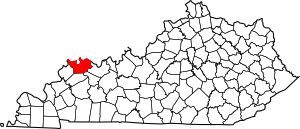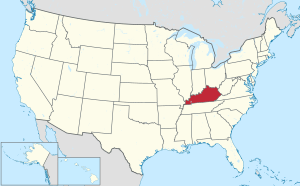Henderson County, Kentucky facts for kids
Quick facts for kids
Henderson County
|
|
|---|---|

Henderson County courthouse in Henderson, Kentucky
|
|

Location within the U.S. state of Kentucky
|
|
 Kentucky's location within the U.S. |
|
| Country | |
| State | |
| Founded | 1798 |
| Named for | Richard Henderson |
| Seat | Henderson |
| Largest city | Henderson |
| Area | |
| • Total | 466 sq mi (1,210 km2) |
| • Land | 437 sq mi (1,130 km2) |
| • Water | 30 sq mi (80 km2) 6.4%% |
| Population
(2020)
|
|
| • Total | 44,793 |
| • Estimate
(2023)
|
44,119 |
| • Density | 96.12/sq mi (37.11/km2) |
| Time zone | UTC−6 (Central) |
| • Summer (DST) | UTC−5 (CDT) |
| Congressional district | 1st |
Henderson County is a county in the U.S. state of Kentucky. The county is located in western Kentucky on the Ohio River across from Evansville, Indiana. As of the 2020 census, the population was 44,793. Its county seat is Henderson.
The county was formed in 1798 and named for Richard Henderson who purchased 17,000,000 acres (69,000 km2) of land from the Cherokee, part of which would later make up the county.
Henderson County lies within the West Kentucky Coal Field area. It is also part of the Evansville, IN-KY Metropolitan Statistical Area.
Contents
History
Henderson County was established in 1798, using land taken from Christian County.
A peninsula across the Ohio from Henderson, which now forms Union Township, Vanderburgh County, Indiana, was the subject of Handly's Lessee v. Anthony, a U.S. Supreme Court case in 1820. An area known as "Green River Island" is part of Kentucky, even though is on the Indiana side of the Ohio River. The Ellis Park Race Course is located there.
Once home to part of the Cherokee Nation, members of the Southern Cherokee were welcomed to Kentucky in 1893 and recognized as an Indian tribe by Governor John Young Brown. The Southern Cherokee still live in Henderson County.
Geography
According to the U.S. Census Bureau, the county has a total area of 466 square miles (1,210 km2), of which 437 square miles (1,130 km2) is land and 30 square miles (78 km2) (6.4%) is water. The county's northern border with Indiana is formed by the Ohio River.
Adjacent counties
- Posey County, Indiana (northwest)
- Vanderburgh County, Indiana (north)
- Warrick County, Indiana (northeast)
- Daviess County (east)
- McLean County (southeast)
- Webster County (south)
- Union County (west)
Demographics
| Historical population | |||
|---|---|---|---|
| Census | Pop. | %± | |
| 1800 | 1,468 | — | |
| 1810 | 4,703 | 220.4% | |
| 1820 | 5,714 | 21.5% | |
| 1830 | 6,659 | 16.5% | |
| 1840 | 9,548 | 43.4% | |
| 1850 | 12,171 | 27.5% | |
| 1860 | 14,262 | 17.2% | |
| 1870 | 18,457 | 29.4% | |
| 1880 | 24,515 | 32.8% | |
| 1890 | 29,536 | 20.5% | |
| 1900 | 32,907 | 11.4% | |
| 1910 | 29,352 | −10.8% | |
| 1920 | 27,609 | −5.9% | |
| 1930 | 26,295 | −4.8% | |
| 1940 | 27,020 | 2.8% | |
| 1950 | 30,715 | 13.7% | |
| 1960 | 33,519 | 9.1% | |
| 1970 | 36,031 | 7.5% | |
| 1980 | 40,849 | 13.4% | |
| 1990 | 43,044 | 5.4% | |
| 2000 | 44,829 | 4.1% | |
| 2010 | 46,250 | 3.2% | |
| 2020 | 44,793 | −3.2% | |
| 2023 (est.) | 44,119 | −4.6% | |
| U.S. Decennial Census 1790–1960 1900–1990 1990–2000 2010–2020 |
|||
As of the census of 2000, there were 44,829 people, 18,095 households, and 12,576 families residing in the county. The population density was 102 per square mile (39/km2). There were 19,466 housing units at an average density of 44 per square mile (17/km2). The racial makeup of the county was 91.16% White, 7.10% Black or African American, 0.16% Native American, 0.33% Asian, 0.01% Pacific Islander, 0.39% from other races, and 0.86% from two or more races. Hispanic or Latino people of any race were 0.97% of the population.
There were 18,095 households, out of which 32.40% had children under the age of 18 living with them, 54.40% were married couples living together, 11.60% had a female householder with no husband present, and 30.50% were non-families. 26.40% of all households were made up of individuals, and 10.60% had someone living alone who was 65 years of age or older. The average household size was 2.43 and the average family size was 2.93.
In the county, the population was spread out, with 24.60% under the age of 18, 8.40% from 18 to 24, 30.00% from 25 to 44, 23.90% from 45 to 64, and 13.10% who were 65 years of age or older. The median age was 37 years. For every 100 females, there were 93.60 males. For every 100 females age 18 and over, there were 90.60 males.
The median income for a household in the county was $35,892, and the median income for a family was $44,703. Males had a median income of $33,838 versus $22,572 for females. The per capita income for the county was $18,470. About 9.70% of families and 12.30% of the population were below the poverty line, including 17.20% of those under age 18 and 10.10% of those age 65 or over.
Communities
Cities
Census-designated places
- Anthoston
- Poole (partially in Webster County)
- Spottsville
Other unincorporated places
- Alzey
- Baskett
- Bluff City
- Cairo
- Dixie
- Finley Addition
- Geneva
- Graham Hill
- Niagara
- Reed
- Scuffletown
- Smith Mills
- Weaverton
- Zion
Notable people
- John James Audubon, ornithologist, painter and naturalist, lived in Henderson 1810–1819
- LaVerne Butler, Kentucky clergyman and university president; born in Henderson County in 1926
- Happy Chandler, 44th and 49th governor of Kentucky; born in the farming community of Corydon, Kentucky in 1898
- Ewing Galloway, journalist and one-time county prosecutor; born in Little Dixie, Kentucky in 1880
- W. C. Handy, musician and composer who became known as the "father of the blues"; lived in Henderson during the 1890s, performing in bands
- Grandpa Jones, country entertainer; born in 1913 in the small farming community of Niagara, Kentucky
- Gary L. Littrell, Command Sergeant Major, born in Henderson in 1944
- Luther Skaggs Jr., Marine corporal; born in Henderson, Kentucky in 1923
See also
 In Spanish: Condado de Henderson (Kentucky) para niños
In Spanish: Condado de Henderson (Kentucky) para niños

